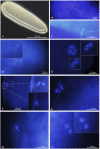Apomixis for no bacteria-induced thelytoky in Diglyphus wani (Hymenoptera: Eulophidae)
- PMID: 36755874
- PMCID: PMC9899834
- DOI: 10.3389/fgene.2022.1061100
Apomixis for no bacteria-induced thelytoky in Diglyphus wani (Hymenoptera: Eulophidae)
Abstract
In Hymenoptera species, the reproductive mode is usually arrhenotoky, where haploid males arise from unfertilized eggs and diploid females from fertilized eggs. In addition, a few species reproduce by thelytoky, where diploid females arise from unfertilized eggs. Diploid females can be derived through various cytological mechanisms in thelytokous Hymenoptera species. Hitherto, these mechanisms were revealed mainly in endosymbiont-induced thelytokous Hymenoptera species. In contrast, thelytokous Hymenoptera species in which a reproductive manipulator has not been verified or several common endosymbionts have been excluded were paid less attention in their cytological mechanisms, for instance, Diglyphus wani (Hymenoptera: Eulophidae). Here, we investigated the cytological mechanism of D. wani using cytological methods and genetic markers. Our observations indicated that the diploid karyotypes of two strains of D. wani consist of four pairs of relatively large metacentric chromosomes and one pair of short submetacentric chromosomes (2n = 10). The arrhenotokous strains could complete normal meiosis, whereas the thelytokous strain lacked meiosis and did not expulse any polar bodies. This reproductive type of lacking meiosis is classified as apomictic thelytoky. Moreover, a total of 636 microsatellite sequences were obtained from thelytokous D. wani, dominated by dinucleotide repeats. Genetic markers results showed all three generations of offspring from thelytokous strain maintained the same genotype as their parents. Our results revealed that D. wani is the first eulophid parasitoid wasp in Hymenoptera whose thelytoky was not induced by bacteria to form an apomictic thelytoky. These findings provide a baseline for future inner molecular genetic studies of ameiotic thelytoky.
Keywords: apomictic thelytoky; cytological mechanism; heterozygosity; karyotype; microsatellite.
Copyright © 2023 Du, Ye, Xu, Liang, Wan, Guo and Liu.
Conflict of interest statement
The authors declare that the research was conducted in the absence of any commercial or financial relationships that could be construed as a potential conflict of interest.
Figures





Similar articles
-
Multiple Data Demonstrate That Bacteria Regulating Reproduction Could Be Not the Cause for the Thelytoky of Diglyphus wani (Hymenoptera: Eulophidae).Insects. 2021 Dec 22;13(1):9. doi: 10.3390/insects13010009. Insects. 2021. PMID: 35055852 Free PMC article.
-
A One-Step Multiplex PCR Method to Rapidly Distinguish Two Strains of Diglyphus wani (Hymenoptera: Eulophidae) Against Agromyzid Leafminers.J Econ Entomol. 2023 Feb 10;116(1):256-262. doi: 10.1093/jee/toac197. J Econ Entomol. 2023. PMID: 36625153
-
Morphological and molecular identification of arrhenotokous strain of Diglyphuswani (Hymenoptera, Eulophidae) found in China as a control agent against agromyzid leafminers.Zookeys. 2021 Nov 17;1071:109-126. doi: 10.3897/zookeys.1071.72433. eCollection 2021. Zookeys. 2021. PMID: 34887696 Free PMC article.
-
Thelytoky and sex determination in the hymenoptera: mutual constraints.Sex Dev. 2014;8(1-3):50-8. doi: 10.1159/000356508. Epub 2013 Dec 7. Sex Dev. 2014. PMID: 24335186 Review.
-
Thelytokous parthenogenesis in eusocial Hymenoptera.Annu Rev Entomol. 2013;58:273-92. doi: 10.1146/annurev-ento-120811-153710. Epub 2012 Oct 15. Annu Rev Entomol. 2013. PMID: 23072461 Review.
Cited by
-
Pan-cancer and multiomics: advanced strategies for diagnosis, prognosis, and therapy in the complex genetic and molecular universe of cancer.Clin Transl Oncol. 2025 Jul;27(7):2936-2954. doi: 10.1007/s12094-024-03819-4. Epub 2024 Dec 26. Clin Transl Oncol. 2025. PMID: 39725831 Review.
-
Genes of the "regulation of lymphocyte activation" pathway may influence immune cells infiltration in growth hormone secreting pituitary tumors.Pituitary. 2025 May 26;28(3):63. doi: 10.1007/s11102-025-01537-w. Pituitary. 2025. PMID: 40415137 Free PMC article.
-
Harnessing the role of aberrant cell signaling pathways in glioblastoma multiforme: a prospect towards the targeted therapy.Mol Biol Rep. 2024 Oct 19;51(1):1069. doi: 10.1007/s11033-024-09996-3. Mol Biol Rep. 2024. PMID: 39424705 Review.
-
Biological role and regulation of circular RNA as an emerging biomarker and potential therapeutic target for cancer.Mol Biol Rep. 2024 Feb 10;51(1):296. doi: 10.1007/s11033-024-09211-3. Mol Biol Rep. 2024. PMID: 38340202 Review.
References
LinkOut - more resources
Full Text Sources

